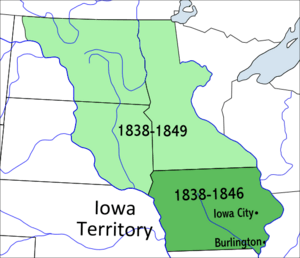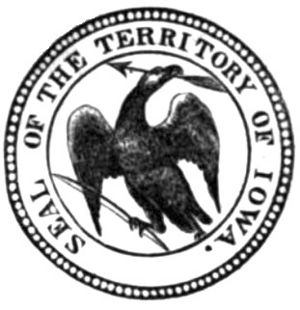Iowa Territory facts for kids
Quick facts for kids Territory of Iowa |
|||||||||
|---|---|---|---|---|---|---|---|---|---|
| Organized incorporated territory of the United States | |||||||||
| 1838–1846 | |||||||||
 The territory that did not become the state of Iowa in 1846 became unorganized territory. The government for this area would become organized as part of the Minnesota Territory in 1849. |
|||||||||
| Capital | Burlington (1838–1841) Iowa City (1841–1849) |
||||||||
| Government | |||||||||
| • Type | Organized incorporated territory | ||||||||
| Governor | |||||||||
|
• 1838–1841
|
Robert Lucas | ||||||||
|
• 1841–1845
|
John Chambers | ||||||||
|
• 1845–1849
|
James Clarke | ||||||||
| Legislature | Iowa Legislative Assembly | ||||||||
| History | |||||||||
|
• Organized from Wisconsin Territory
|
4 July 1838 | ||||||||
| 28 December 1846 | |||||||||
|
|||||||||
The Territory of Iowa was a special area in the United States that had its own government. It existed from July 4, 1838, until December 28, 1846. On that date, the southeastern part of the territory became the state of Iowa.
The rest of the territory did not have an organized government right away. It became part of the Minnesota Territory later, on March 3, 1849.
Contents
History of the Iowa Territory
Most of the land that became the Iowa Territory was originally bought by the U.S. in the Louisiana Purchase. This huge area was once part of the Missouri Territory.
When Missouri became a state in 1821, the land that would become Iowa was left without an official government. It was called "unorganized territory." White settlers were not allowed to move there until the 1830s. This was after the Black Hawk War ended.
On June 28, 1834, this area became part of the Michigan Territory. In September 1834, the Iowa District was divided into two counties. These were Dubuque County to the north and Des Moines County to the south.
When Michigan became a state in 1836, the Iowa area became the Iowa District of the western Wisconsin Territory. This was the region west of the Mississippi River.
Territory Boundaries and Capitals
The Iowa Territory was officially created in 1838. Its original borders were very large. They included all of present-day Minnesota and parts of the Dakotas. This covered about 194,000 square miles (502,000 square kilometers) of land.
At first, Burlington was the temporary capital of the territory. Later, in 1841, Iowa City was chosen as the official territorial capital. Fort Snelling was also located within the territory until Iowa became a state.
Becoming a State
Iowa officially became a state on December 28, 1846. When this happened, the remaining parts of the territory were left without an organized government.
Lawmakers tried to create a new territory for this land. Finally, the Minnesota Territory was formed on March 3, 1849. This solved the problem of the unorganized land.
Population in 1840
The 1840 United States census counted the people living in the Iowa Territory. Here's how many people lived in each of the 18 counties:
| Rank | County | Population |
|---|---|---|
| 1 | Van Buren | 6,146 |
| 2 | Lee | 6,093 |
| 3 | Des Moines | 5,577 |
| 4 | Henry | 3,772 |
| 5 | Dubuque | 3,059 |
| 6 | Jefferson | 2,773 |
| 7 | Muscatine | 1,942 |
| 8 | Louisa | 1,927 |
| 9 | Washington | 1,594 |
| 10 | Johnson | 1,491 |
| 11 | Jackson | 1,411 |
| 12 | Linn | 1,373 |
| 13 | Cedar | 1,253 |
| 14 | Scott | 1,240 |
| 15 | Clayton | 1,101 |
| 16 | Clinton | 821 |
| 17 | Jones | 471 |
| 18 | Delaware | 168 |
| Unincorporated | 900 | |
| Iowa Territory | 43,112 |
How the Territory Was Governed
The Iowa Territory had its own government. The main leaders were the Governor, a Secretary, a Treasurer, and an Auditor. The Secretary would take over if the Governor was not able to do their job.
Territorial Leaders (1838–1846)
Here are some of the important people who led the Iowa Territory:
Governors
- Robert Lucas, started in 1838.
- John Chambers, started in 1841.
- James Clarke, started in 1845.
Secretaries
- William B. Conway, started in 1838; passed away in November 1839.
- James Clarke, started in 1839.
- O. H. W. Stull, started in 1841.
- Samuel J. Burr, started in 1843.
- Jesse Williams, started in 1845.
Auditors
- Jesse Williams, started in 1840.
- William L. Gilbert, started in 1843.
- Robert M. Secrest, started in 1845.
Treasurers
- Thornton Bayless, started in 1839.
- Morgan Reno, started in 1840.
Representatives in Congress
These people represented the Iowa Territory in the U.S. Congress:
- William W. Chapman in the 25th and 26th Congresses (1838–1840).
- Francis Gehon, chosen in 1839, but never officially served.
- Augustus C. Dodge, in the 27th, 28th, and 29th Congresses (1840–1846).
Territorial Legislature
The territory also had a law-making body called the Iowa Legislative Assembly. It was made up of two parts:
- The "Council," which had 13 members. This was like a Senate.
- The "House of Representatives," which had 26 members.
See also
 In Spanish: Territorio de Iowa para niños
In Spanish: Territorio de Iowa para niños



